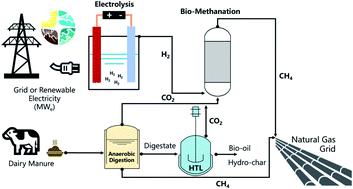当前位置:
X-MOL 学术
›
Sustain. Energy Fuels
›
论文详情
Our official English website, www.x-mol.net, welcomes your
feedback! (Note: you will need to create a separate account there.)
Integrating anaerobic digestion, hydrothermal liquefaction, and biomethanation within a power-to-gas framework for dairy waste management and grid decarbonization: a techno-economic assessment
Sustainable Energy & Fuels ( IF 5.0 ) Pub Date : 2020-07-03 , DOI: 10.1039/d0se00608d Nazih Kassem 1, 2, 3, 4, 5 , James Hockey 3, 5, 6 , Camilo Lopez 7, 8, 9 , Laurent Lardon 7, 8, 9 , Largus T. Angenent 9, 10, 11, 12 , Jefferson W. Tester 3, 3, 5, 6, 13
Sustainable Energy & Fuels ( IF 5.0 ) Pub Date : 2020-07-03 , DOI: 10.1039/d0se00608d Nazih Kassem 1, 2, 3, 4, 5 , James Hockey 3, 5, 6 , Camilo Lopez 7, 8, 9 , Laurent Lardon 7, 8, 9 , Largus T. Angenent 9, 10, 11, 12 , Jefferson W. Tester 3, 3, 5, 6, 13
Affiliation

|
This study highlights the potential of combining energy and dairy waste management systems to maximize resource recovery and reduce dairy farming environmental impacts. A combined anaerobic digestion, hydrothermal liquefaction, and a biomethanation process system was used to generate Renewable Natural Gas (RNG). The biomethanation step is part of a Power-to-Gas (PtG) system incorporating an electrolyzer that generates hydrogen to react with carbon dioxide to produce additional RNG. A distributed system of biorefineries was utilized to evaluate the economic feasibility of producing renewable biomethane for gas pipeline injection in an effort to decarbonize New York's natural gas grid and lower environmental impacts. Considering the waste produced by 397 000 dairy cows in NY State, this distributed biorefinery system was shown to generate 22 million MJ of RNG per year. The RNG selling price, as defined by carbon credit pricing mechanisms, was found to be the most critical factor in determining economic viability. For example, using the Low Carbon Fuel Standard (LCFS) and the Renewable Fuel Standard (RFS) result in a $7 billion 20 year NPV and a competitive effective Levelized Cost of Energy (LCOEe) of $10 per GJ.
中文翻译:

将厌氧消化,水热液化和生物甲烷化整合到电力到天然气的框架中,以管理乳制品废物和电网脱碳:技术经济评估
这项研究强调了将能源和奶制品废物管理系统相结合以最大程度地提高资源回收率并减少奶业对环境的影响的潜力。组合的厌氧消化,水热液化和生物甲烷化工艺系统被用于产生可再生天然气(RNG)。生物甲烷化步骤是功率为气(PtG)系统的一部分,该系统集成了一个电解器,该电解器产生氢与二氧化碳反应以产生额外的RNG。利用分布式生物精炼厂系统评估生产可再生生物甲烷用于天然气管道注入的经济可行性,以努力使纽约的天然气网格脱碳并降低环境影响。考虑到纽约州39.7万头奶牛产生的废物,事实证明,这种分布式生物精炼系统每年可产生2200万兆焦耳的RNG。碳信用定价机制定义的RNG售价被认为是决定经济可行性的最关键因素。例如,使用低碳燃料标准(LCFS)和可再生燃料标准(RFS)可获得20亿美元的20年NPV和具有竞争力的有效平均能源成本(LCOE)e)每GJ $ 10。
更新日期:2020-08-25
中文翻译:

将厌氧消化,水热液化和生物甲烷化整合到电力到天然气的框架中,以管理乳制品废物和电网脱碳:技术经济评估
这项研究强调了将能源和奶制品废物管理系统相结合以最大程度地提高资源回收率并减少奶业对环境的影响的潜力。组合的厌氧消化,水热液化和生物甲烷化工艺系统被用于产生可再生天然气(RNG)。生物甲烷化步骤是功率为气(PtG)系统的一部分,该系统集成了一个电解器,该电解器产生氢与二氧化碳反应以产生额外的RNG。利用分布式生物精炼厂系统评估生产可再生生物甲烷用于天然气管道注入的经济可行性,以努力使纽约的天然气网格脱碳并降低环境影响。考虑到纽约州39.7万头奶牛产生的废物,事实证明,这种分布式生物精炼系统每年可产生2200万兆焦耳的RNG。碳信用定价机制定义的RNG售价被认为是决定经济可行性的最关键因素。例如,使用低碳燃料标准(LCFS)和可再生燃料标准(RFS)可获得20亿美元的20年NPV和具有竞争力的有效平均能源成本(LCOE)e)每GJ $ 10。









































 京公网安备 11010802027423号
京公网安备 11010802027423号